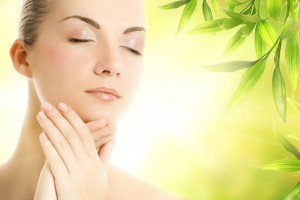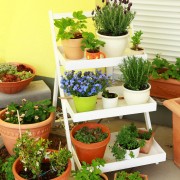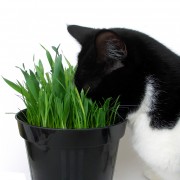Beauty Care and Your Garden
Beauty Care and Your Garden (Resin and Herbs)
Resinous substances may occur alone or in combination with essential oils or gums. Resins are unlike gums as they are insoluble in water, but they dissolve in other solvents including alcohol. Resin production occurs in various plants in nature, but only a few families are of commercial considerations. These include the Anacardiaceae (the sumac family), Burseraceae (the incense tree family), Cannabaceae (the hemp family), Dipterocarpaceae (major importance timber trade), Guttiferae (primarily tropical-some species offer resin which bees use in nest construction), Hammamelidaceae (the witch hazel family), Lamiaceae (mint family – culinary & essential oils), Liliaceae (the lily family), Meliaceae (the mahogany family), Pinaceae (the pine family of conifers), Styracaceae (the silver bells family – are evergreen or deciduous trees or shrubs) and Umbelliferae (the parsley family). The true botanical origin of a resin is often generally not definitive, especially in the case where they derive from fossil or semi fossil types.

Beauty Care and Your Garden (Resin and Herbs)
An important property of resins that is applied in industrial aspects is their ability to dissolve in alkalis to form soap. Resins also have antiseptic properties and are also used in medicine for such things as in the preparation of sealing wax, incense and perfumes; and for many other purposes as well.
The use of different plants is determined by their physiological activity and their dermatological properties, which varies from one plant species to another so we can find a plant for nearly all our aesthetic needs. Parabens are another item which people should have concerns for personal safety within the products they use. “Parabens are the most widely used preservative in cosmetics. They are also used as fragrance ingredients, but consumers won’t find that listed on the label.” There are also a vast range of formulas for cosmetic, hygienic and general skin care preparations, as there are plant extracts, in make-up, creams, emulsions, facial masks, lotions, gels, oils (massage), salves, sunscreen and tanning or solar moisturizers, soaps (liquids), toothpastes, bath products, and deodorants.
We would like to assert ourselves with the notation of warnings on labels when it comes to chemicals in cosmetics as phthalates (DEP-diethyl phthalate) are known to be the cause of endocrine disruption which are cancer causing and in many cases around North America the benchmark levels are exceeded in most children through their daily diet for substances such as arsenic, dieldrin, DDE, and dioxins. Health Canada notes evidence suggesting that exposure to phthalates may cause liver and kidney failure in young children when products containing phthalates are sucked or chewed for extended periods. Phthalates are also listed as a Priority and Toxic Pollutant under the US Clean Water Act based on evidence that it can be toxic to wildlife and the environment. Another great reason to start your journey within your home gardening, there is no need to place these chemical burdened bi-products onto our bodies or into the environment.
Second to phthalates, “BHA (butylated hydroxyanisole) and BHT (butylated hydroxytoluene) are closely related synthetic antioxidants used as preservatives in lipsticks and moisturizers, among other cosmetics. They are also widely used as food preservatives the use of BHA and BHT in cosmetics is unrestricted in Canada, although Health Canada has categorized BHA as a “high human health priority” on the basis of carcinogenicity and BHT as a “moderate human health priority”. Both chemicals have been flagged for future assessment under the government’s Chemicals Management Plan.
International regulations are stronger. The European Union prohibits the use of BHA as fragrance ingredient in cosmetics. The State of California requires warning labels on products containing BHA, notifying consumers that this ingredient may cause cancer.
International regulations are stronger. The European Union prohibits the use of BHA as fragrance ingredient in cosmetics. The State of California requires warning labels on products containing BHA, notifying consumers that this ingredient may cause cancer.”
Another great reason to start your journey within your home gardening, there is no need to place these chemical burdened bi-products onto our bodies or into the environment when in fact there are naturally occurring substances that are derived from plant materials which can be placed into our everyday cosmetic recipes.
In short, we recommend growing your own plant life all year round for your home-made recipes, and using our LED grow lights is a definitive way to attain a bountiful harvest for a natural and organic alternative to store bought supplies. With great reason, we grow organically for a healthy and safe food supply, for a clean and sustainable environment, and of course because the results from the experience is enjoyable and rewarding, from seed to harvest.
Great interest has been ‘growing’ for lack of a better word when consumers decide to create their own formulas for their cosmetic needs. One of the key factors with the active ingredients is the antioxidant value that each substance contains. Antioxidants prevent the degradation of ingredients in cosmetic products such as proteins, lipids and sugars. The more nutrient dense your plant life that you grow in your garden is, the more likely your materials you will use for your cosmetic recipes. These very essential nutrients and vitamins protect and nurture cells naturally, combating disease and promoting good health. Antioxidants come in many forms, including minerals, enzymes and vitamins. Vitamins and minerals with antioxidant properties are called nutrient antioxidants which boost skin radiance, elasticity, resilience and suppleness and they can improve cell function; increase collagen production.
Some herb’s that contribute to a high concentration of antioxidants which you can grow all year round in your organic garden are: Oregano, dill, thyme, rosemary and peppermint. Less familiar herbs with comparable antioxidant-power include rose geranium, sweet bay, purple amaranth, winter savory and Vietnamese coriander. Some spices include: Tumeric, cinnamon, ginger and cloves.
Most bioactive food constituents are derived from plants; those so derived antioxidants are also called phytochemicals and range in the capacity of fruits, vegetables, spices and herbs in addition to common everyday foods. There are numerous individual functions as well as a combined synergistic effects (individually or combined together) from your fresh grown plantations for your recipes which are indeed more active and crucial to your health which you definitely benefit from.
Some of the most common plants that can be considered for your garden and can be used in a natural and organic way for general hygiene and cosmetic products are as follows:
Aloe, Arrowroot, Basil, Beeswax, Borage, Calendula, Cane Sugar, Carrot, Chamomile, Citronella, Cucumber, (Lemon) Cucumber, Fennel, Ginger, Gotu Kola, Hibiscus, Lavender, Lemongrass, Mint, Neem, Oregano, Passionflower, Peppermint, Plantain Leaf, Rosemary, Sage, Spearmint, Stevia, Thyme, and Vertiver (Chrysopogon zizaniodes).
We are currently moving forward with a trial grow of Avocado, Cayenne Pepper and Goji berries (Wolfberries) and hope to try growing things like Cinnamon, Coffee, Vanilla (but this will be a very hard one – in home) and Popcorn (this will be a fun one, indoors).
References: Glycerol, Essential Oil, Parabens, Dibutyl-phthalate, Endocrine Distruptors, BHA (butylated hydroxyanisole)




